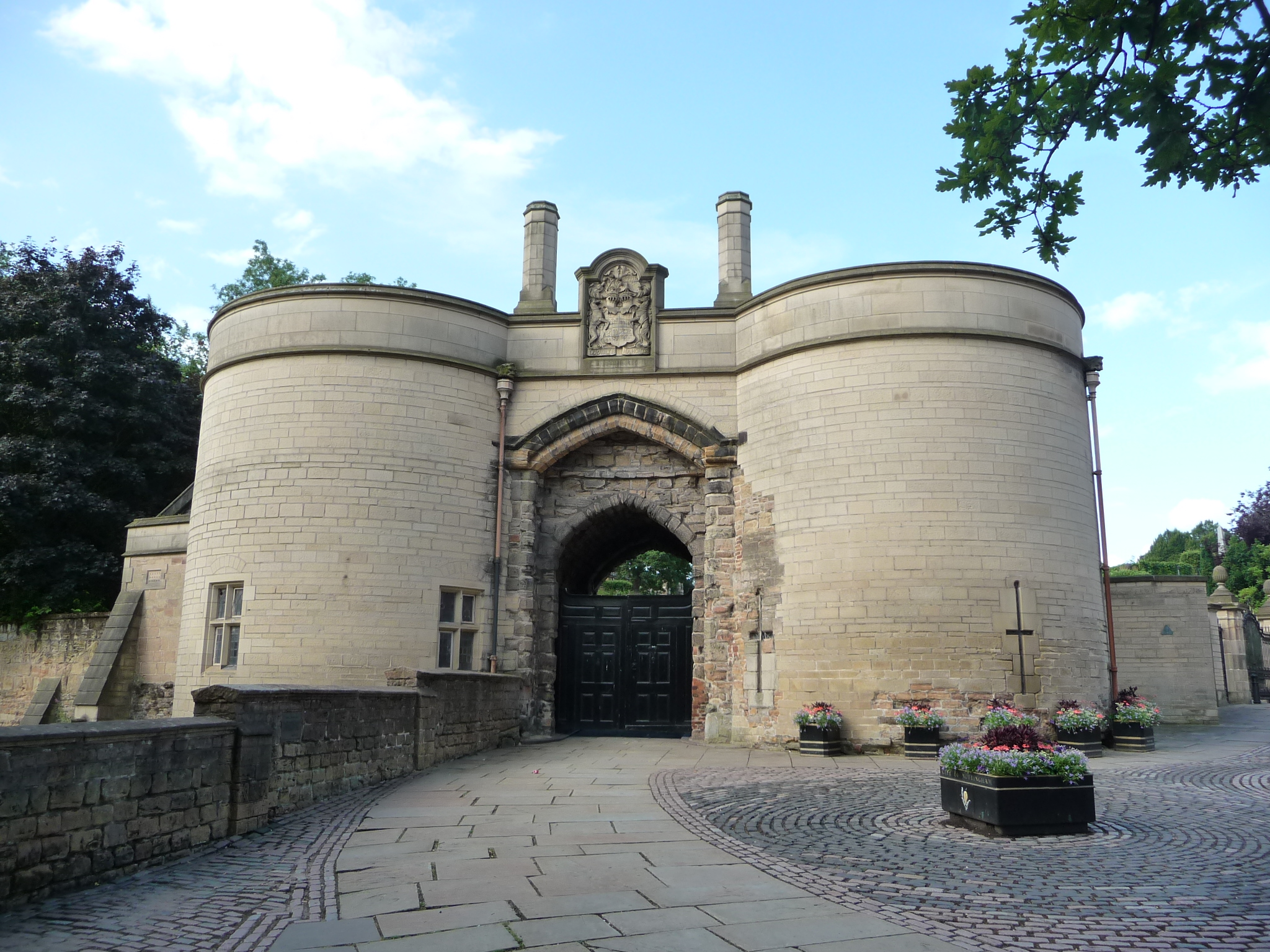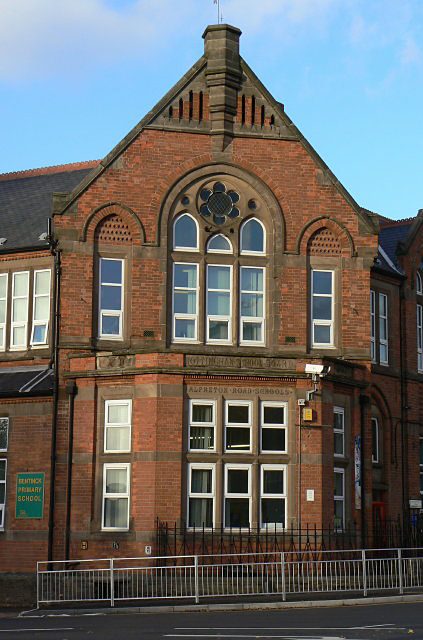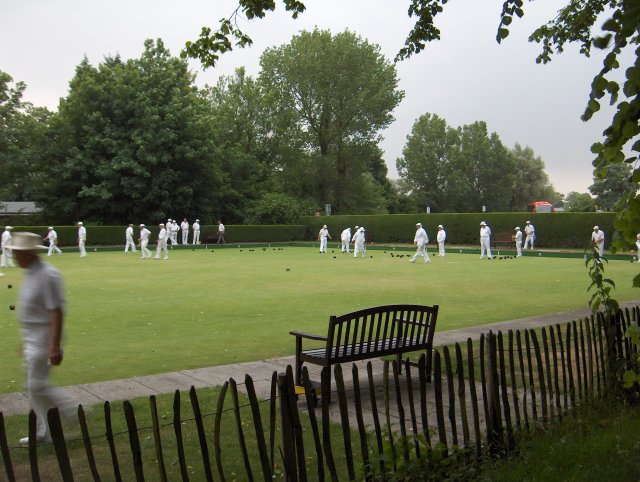|
Hyson Green
Hyson Green is a neighbourhood in Nottingham, England. It is home to a variety of cultures with a thriving local economy. Hyson Green has the largest ethnic minority population in the city. Since 2006 Hyson Green has seen a larger rise in development and direct international investment than any other area of Nottingham. Hyson Green is spread over Berridge and Arboretum wards of Nottingham. While the local economy is improving, child poverty remains higher than average, as listed in Nottingham City Council's ward profiles. The area is served by Radford Road tram stop and Hyson Green Market tram stop on the Nottingham Express Transit. The opening of the tram system has boosted Hyson Green's profile and helped to regenerate the area. History Hyson Green was built on the southern part of the Basford and Nottingham Lings, a large sandy waste of gorse bushes, ling, and heather with patches of grass. After the Norman Conquest it became part of the demesne of William Peverel, chief ... [...More Info...] [...Related Items...] OR: [Wikipedia] [Google] [Baidu] |
City Of Nottingham
Nottingham ( , East Midlands English, locally ) is a City status in the United Kingdom, city and Unitary authorities of England, unitary authority area in Nottinghamshire, East Midlands, England. It is located south-east of Sheffield and north-east of Birmingham. Nottingham is the legendary home of Robin Hood and to the lace-making, bicycle and Smoking in the United Kingdom, tobacco industries. The city is also the county town of Nottinghamshire and the settlement was granted its city charter in 1897, as part of Queen Victoria's Diamond Jubilee celebrations. In the 2021 United Kingdom census, 2021 Census, Nottingham had a reported population of 323,632. The wider conurbation, which includes many of the city's suburbs, has a population of 768,638. It is the largest urban area in the East Midlands and the second-largest in the Midlands. Its Functional Urban Area, the largest in the East Midlands, has a population of 919,484. The population of the Nottingham/Derby metropolitan a ... [...More Info...] [...Related Items...] OR: [Wikipedia] [Google] [Baidu] |
Radford, Nottingham
Radford is an inner-city area of Nottingham and former civil parish in the Nottingham district, in the ceremonial county of Nottinghamshire, England, located just outside the city centre. The appropriate ward of the City of Nottingham Council is Radford and Park which, in 2011, had a population of 21,414. It is bounded to the south by Lenton, Nottingham, Lenton and to the east by Nottingham city centre, and comprises around of land. History St Peter's Church, Radford was given by William Peveril to Lenton Priory. The church was rebuilt in 1812 at a cost of £2,000. A Wesleyan Methodist Church (Great Britain), Wesleyan chapel was built in 1805 and enlarged in 1828. In September 1878 a chapel was built on St Peter's Street by the United Methodist Free Churches at a cost of £1,900. It was closed owing to declining membership and income in June 1947 and purchased by the Evangelical Free Church. Bentinck Road School opened on 19 November 1880, and was formerly called the Alfreto ... [...More Info...] [...Related Items...] OR: [Wikipedia] [Google] [Baidu] |
Basford, Nottingham
Basford is a northerly suburb of Nottingham, in Nottinghamshire, England, incorporated into the city in 1877. It gave its name to Basford Rural District, which existed from 1894 to 1974. The ward population at the 2011 census was 16,207, estimated at 16,779 in 2019. Next to Old Basford is New Basford, which is mainly Victorian. Basford lies close to the River Leen, a tributary of the River Trent. It is linked to Nottingham City Centre to the south and Hucknall and Bulwell to the north by the Nottingham Express Transit tram service. Toponymy The name appears as ''Baseford'' in the Domesday survey of 1086; Basford contains the Old English personal name ''Basa'', + ''ford'' (Old English), 'a ford', so 'Basa's ford'. History "Basford Parish lies principally in the vale of the Leen, where that river is augmented by two small streams called the Day Brook and White Moor Spring; but its eastern extremity rises to the lofty hills of Mapperley. It extends from one and a half to ... [...More Info...] [...Related Items...] OR: [Wikipedia] [Google] [Baidu] |
Stocking Frame
A stocking frame was a mechanical knitting machine used in the textiles industry. It was invented by William Lee of Calverton near Nottingham in 1589. Its use, known traditionally as framework knitting, was the first major stage in the mechanisation of the textile industry, and played an important part in the early history of the Industrial Revolution. It was adapted to knit cotton and to do ribbing, and by 1800 had been adapted as a lace making machine. Description Lee's machine consisted of a stout wooden frame. It did straight knitting, not tubular knitting. It had a separate needle for each loop - these were low carbon steel bearded needles where the tips were reflexed and could be depressed onto a hollow, closing the loop. The needles were supported on a needle bar that passed back and forth, to and from the operator. The beards were simultaneously depressed by a presser bar. The first machine had eight needles per inch and was suitable for worsted. The next version had 1 ... [...More Info...] [...Related Items...] OR: [Wikipedia] [Google] [Baidu] |
Brass Foundry
A foundry is a factory that produces metal castings. Metals are cast into shapes by melting them into a liquid, pouring the metal into a mold, and removing the mold material after the metal has solidified as it cools. The most common metals processed are aluminum and cast iron. However, other metals, such as bronze, brass, steel, magnesium, and zinc, are also used to produce castings in foundries. In this process, parts of desired shapes and sizes can be formed. Foundries are one of the largest contributors to the manufacturing recycling movement, melting and recasting millions of tons of scrap metal every year to create new durable goods. Moreover, many foundries use sand in their molding process. These foundries often use, recondition, and reuse sand, which is another form of recycling. Process In metalworking, casting involves pouring liquid metal into a mold, which contains a hollow cavity of the desired shape, and then allowing it to cool and solidify. The solidified pa ... [...More Info...] [...Related Items...] OR: [Wikipedia] [Google] [Baidu] |
Nottingham And District Tramways Company Limited
Nottingham and District Tramways Company Limited was a tramway operator from 1875 to 1897 based in Nottingham in the United Kingdom. Nottingham Tramways Company 1872-1875 Plans for tramways in the town of Nottingham started at least as early as 1870 and sufficient progress was made by several prominent business men to formally establish the Nottingham Tramways Company in 1872. The corporation Highways Committee reported on 8 January 1872 that the Nottingham Tramways Company Limited has asked for consent to an application to the Board of Trade for a provisional order authorising them to construct tramways to Arnold, Beeston, Bulwell and Carlton. No plans for this proposed network survive in the local archives in Nottingham. In November 1872 the company issued notice that they intended to submit a bill to Parliament for the operation of tramways in Nottingham. The proposed network made no mention of Arnold or Beeston but comprised a line from a terminus on Forest Road at it ... [...More Info...] [...Related Items...] OR: [Wikipedia] [Google] [Baidu] |
Gas Lighting
Gas lighting is the production of artificial light from combustion of a fuel gas such as methane, propane, butane, acetylene, ethylene, hydrogen, carbon monoxide, coal gas (town gas) or natural gas. The light is produced either directly by the flame, generally by using special mixes (typically propane or butane) of illuminating gas to increase brightness, or indirectly with other components such as the gas mantle or the limelight, with the gas primarily functioning to heat the mantle or the lime to incandescence. Before electricity became sufficiently widespread and economical to allow for general public use, gas lighting was prevalent for outdoor and indoor use in cities and suburbs where the infrastructure for distribution of gas was practical. At that time, the most common fuels for gas lighting were wood gas, coal gas and, in limited cases, water gas. Early gas lights were ignited manually by lamplighters, although many later designs are self-igniting. Gas light ... [...More Info...] [...Related Items...] OR: [Wikipedia] [Google] [Baidu] |
Municipal Corporations Act 1835
The Municipal Corporations Act 1835 ( 5 & 6 Will. 4. c. 76), sometimes known as the Municipal Reform Act, was an act of the Parliament of the United Kingdom that reformed local government in the incorporated boroughs of England and Wales. The legislation was part of the reform programme of the Whigs and followed the Reform Act 1832, which had abolished most of the rotten boroughs for parliamentary purposes. Royal commission The government of Lord Grey, having carried out reform of parliamentary constituencies, turned its attention to local government. In February 1833 a select committee was appointed "to inquire into the state of the Municipal Corporations in England, Wales, and Ireland; and to report if any, and what abuses existed in them, and what measures, in their opinion, it would be most expedient to adopt, with a view to the correction of those abuses". The committee made their report in June 1833, having inquired into a handful of boroughs. The committee found that ... [...More Info...] [...Related Items...] OR: [Wikipedia] [Google] [Baidu] |
John Pepper
József Pogány, known in English as John Pepper or Joseph Pogany, (November 8, 1886 – February 8, 1938) was a Hungarian Communist politician. He later served as a functionary in the Communist International (Comintern) in Moscow, before being cashiered in 1929. Later as an official in the Soviet government, Pepper ran afoul of the secret police and was executed during the Great Terror of 1937–38. Background József Pogány was born József Schwartz in Budapest in Hungary. He was the first of three children. His family were ethnic Jews, but he himself adopted the Hungarian name ''Pogány'' to de-emphasize his Jewish origins. His father, Vilmos Schwarz, was a tradesman who became a minor civil servant; he also served Chevra Kadisa synagogue in Pest. His mother Hermina Weinberger was a hairdresser. He was not related to artist Willy Pogany, as was once claimed by Whittaker Chambers. Pogány studied at the University of Budapest (1904-1908); he spent his last six months of s ... [...More Info...] [...Related Items...] OR: [Wikipedia] [Google] [Baidu] |
Public-house
A pub (short for public house) is in several countries a drinking establishment licensed to serve alcoholic drinks for consumption Licensing laws of the United Kingdom#On-licence, on the premises. The term first appeared in England in the late 17th century, to differentiate private houses from those open to the public as alehouses, taverns and inns. Today, there is no strict definition, but the Campaign for Real Ale (CAMRA) states a pub has four characteristics: # is open to the public without membership or residency # serves draught beer or cider without requiring food be consumed # has at least one indoor area not laid out for meals # allows drinks to be bought at a bar (i.e., not only table service) The history of pubs can be traced to taverns in Roman Britain, and through Anglo-Saxon alehouses, but it was not until the early 19th century that pubs, as they are today, first began to appear. The model also became popular in countries and regions of British influence, whe ... [...More Info...] [...Related Items...] OR: [Wikipedia] [Google] [Baidu] |
Bowling Green
A bowling green is a finely laid, close-mown and rolled stretch of turf for playing the game of bowls. Before 1830, when Edwin Beard Budding of Thrupp, near Stroud, UK, invented the lawnmower, lawns were often kept cropped by grazing sheep on them. The world's oldest surviving bowling green is the Southampton Old Bowling Green, which was first used in 1299. When the French adopted "boulingrin" in the 17th century, it was understood to mean a sunk geometrically shaped piece of perfect grass, framed in gravel walks, which often formed the centre of a regularly planted wood called a '' bosquet'', somewhat like a highly formalized glade; it might have a central pool or fountain. The diarist Samuel Pepys Samuel Pepys ( ; 23 February 1633 – 26 May 1703) was an English writer and Tories (British political party), Tory politician. He served as an official in the Navy Board and Member of Parliament (England), Member of Parliament, but is most r ... relates a conversation h ... [...More Info...] [...Related Items...] OR: [Wikipedia] [Google] [Baidu] |
Tea Garden
A tea garden is an outdoor space where tea and light refreshments are served, or any garden with which the drinking of tea is associated. Especially in India, it is also a common term for a tea plantation. The tea garden was a part of early English commercial pleasure gardens; often parties of couples visited these, the men occupying themselves with lawn bowls and beer or wine, while the ladies went to the tea garden. In modern times it often means an outside area at a cafe or tearoom. In Japanese gardening, a ''roji'' is a particular style of relatively small garden, originally developed for the entry gardens to Chashitsu, Japanese teahouses, intended to set the mood of guests arriving for the Japanese tea ceremony. These are designed almost exclusively to be seen from the path leading through them to the building, and tea would not normally be consumed in them. The style is suitable for smaller front gardens of houses, and has often been used for these, both in Japan and th ... [...More Info...] [...Related Items...] OR: [Wikipedia] [Google] [Baidu] |








